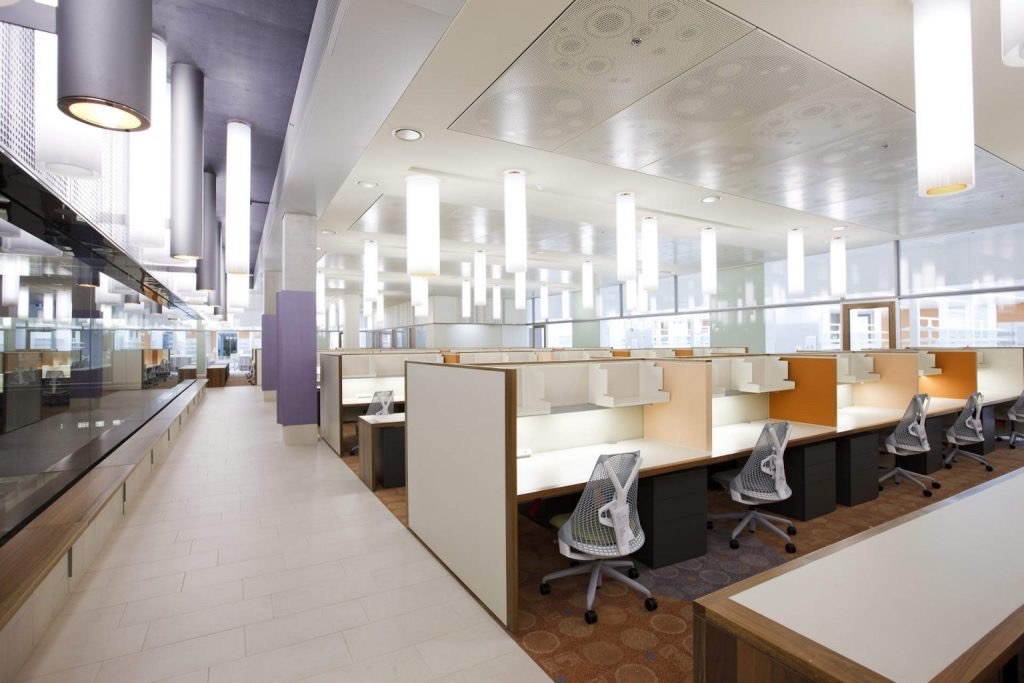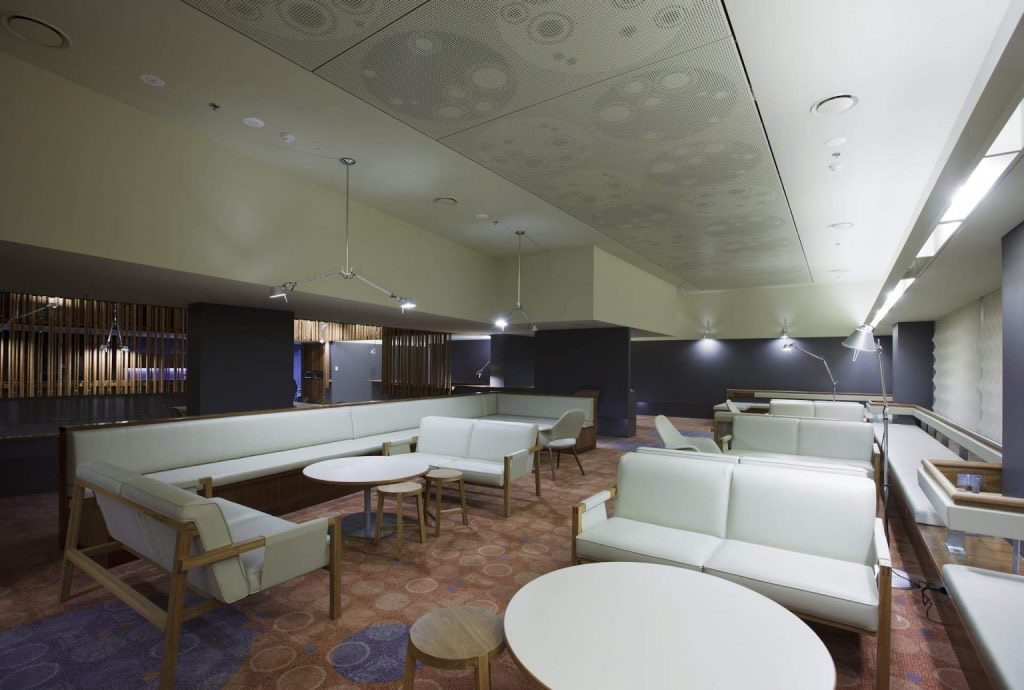As a company that designs acoustic ceiling panels and systems, Metrix Group have discovered what the ceiling industry has known for years; it’s still booming. However, the growing popularity of metal ceilings with their visual appeal, durability, sound dampening properties, among other factors, is a relatively new-comer to the scene.
One of the key reasons for their widespread acceptance is the sleek, upscale look they bring to any room. These aesthetic features make it an ideal choice for high visibility spaces, such as lobbies and offices, as well as in public places like airports and train stations. Speed of install also make them a highly sort-after solution for public works that require interior styling.
Perforated metal sheets are humidity resistant, easy to install and cost-effective. With the prevalence of out-dated mineral-fibre ceiling tiles in standard 600 x 600 ceiling systems, Metrix Group’s perforated and pressed metal ceilings panels are a quick and inexpensive way to create an instant visual and acoustic effect

Perforated ceilings provide great acoustics
Perforated metal ceilings can offer both aesthetic and acoustic benefits. However, they require special installation techniques and materials. This can be done through a combination of perforated metal sheets and sound absorbing materials, such as mineral wool board (MWB) and/or open cell polyurethane foam (OCF).
The thickness or density, and mounting methods affect the sound absorbing properties of the back loaded acoustical materials. In typical back loading situations, the material is applied directly onto the perforated surface. The addition of an airspace between the perforated panel and the building’s roof will increase acoustic attenuation.
The size, shape, and arrangement of the holes affect the acoustic performance of the ceiling panel – which may allow sounds to pass through and be absorbed by the ceiling panel. A consultation with our design studio will help ascertain the appropriate NRC.
The NRC or Noise Reduction Coefficient is a combined measure of how much sound is absorbed by a material or object over all human frequencies. The ratings are expressed as a value between 0 (no sound absorbed) and 1 (all sound absorbed). Typically, Metrix Group acoustic products are designed for ratings between 0.4 – 0.85.

Types of perforated holes
There are three categories of perforations to choose from to achieve different aesthetic effects depending upon the room’s design and the desired attenuation. Metrix Group had a range of 2D and 3D products tested via the CSIRO. The range included 10 – 60% open area across varying gauges of mild steel and aluminium. Air gaps and varying acoustic backing up to 50mm were used throughout the tests. Test results can be shared on request.
Highly perforated
These products have a perforated or open area of more than 60% of the surface area.
When the open area percentage of the surface is above 60%, the acoustic absorbance of the back is much higher. A minimum 200 mm air gap above the ceiling helps with performance in this situation.
Because they’re highly permeable, highly perforated ceilings are often used in retail stores, particularly small boutiques, and in hospitality environments and gyms.
Moderately perforated
These ceiling tiles have an open area of 20 – 60 percent. They’re usually round but Metrix Group have a range of classicPerf™ including square, rectangular and slot hole tiles available too. These are commonly found in offices, schools, and hospitals.
Minimally perforated
As the name implies, these products are designed to reflect sounds back into the room instead of absorbing them, which means they rely less on any kind of acoustic treatments behind them for their effectiveness.
These ceilings can offer excellent acoustic properties if they’re designed well and have adequate backing material. The open area in often less than 20%.
The perforations are less visible and give the appearance of a more solid ceiling. The Metrix Group website offers the opportunity to search by open area to narrow down the optimal choice of pattern for the desired outcome.
The Example below will provide a moderate range of open area:
https://www.metrixgroup.com.au/standard-perforation/?filter_open-area=41-60
There are several factors that determine whether or not sound can travel through perforated metal panels.
These include:
- Thickness of metal
- Number of perforations
- Diameter of the perforation
- Number of holes per inch
- Percentage of open panel space
Larger perforated holes, closely spaced, on thinner metal provide the best acoustics. Thicker metal with smaller holes spaced farther apart blocks sounds better.
Perforations can be varied according to individual taste, from large punched hexagons, smaller punched dots and custom shapes. Even though perforation patterns differ, material, open area, acoustic bats and ceilings gap will help transform flat ceilings into something eye catching with high performance.
Metrix Group – providing quality acoustic performance from perforated panels.
Noise control in modern architecture has become an important factor for architects and building owners. It’s no longer only the concern of auditoriums and theatres. High traffic offices and large volume commercial sites are recognising the advantage of pre-planning acoustic performance.
Metrix Group acoustic insulation products combined with our perforated ceilings and walling systems consistently achieve NRC ratings of 0.4 – 0.85; a very comfortable rating for any commercial space.
A conversation with our Design Studio can help transform your planning into realistic, high performing solutions.
Suggested read: A Guide to Architectural Metal Cladding
